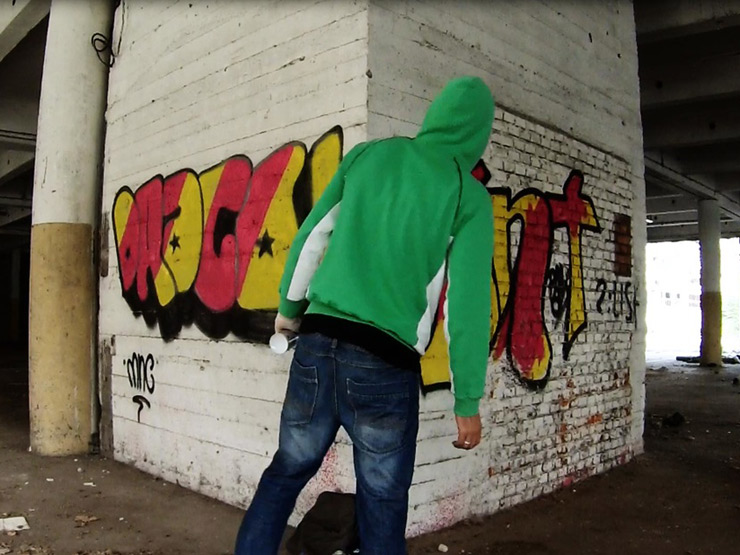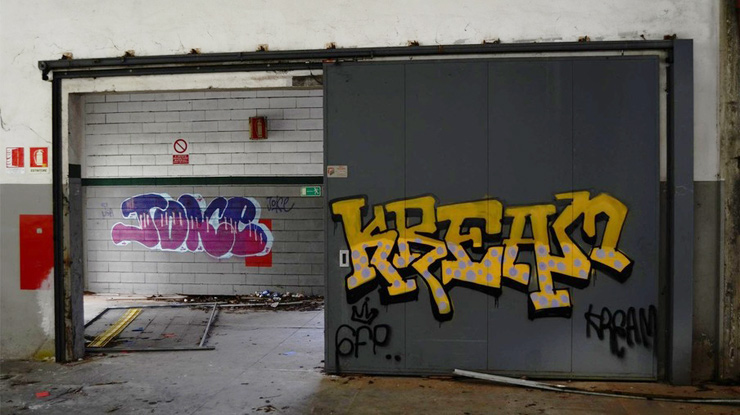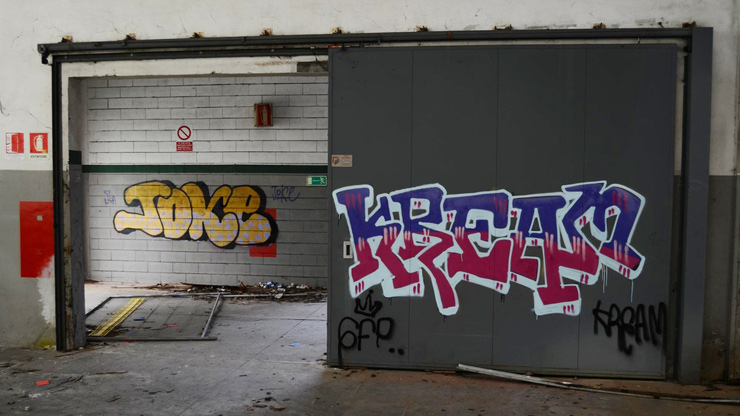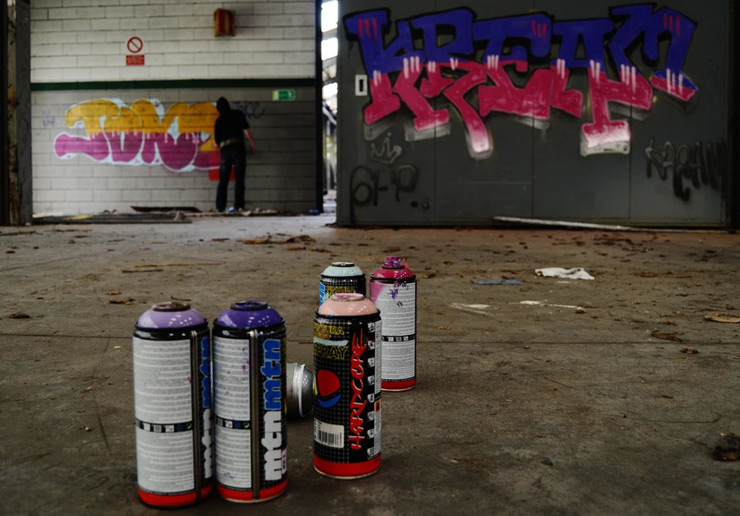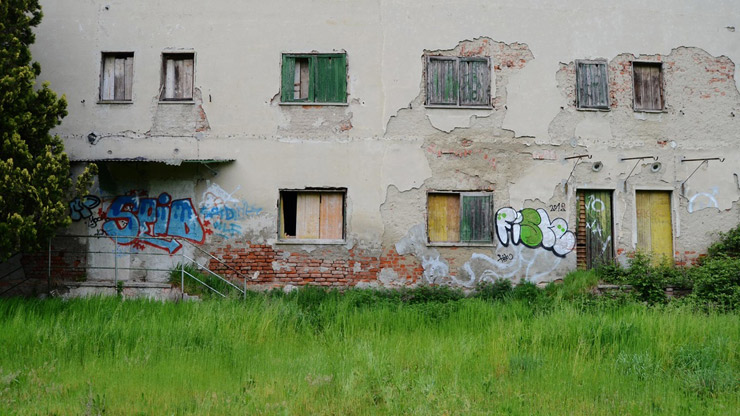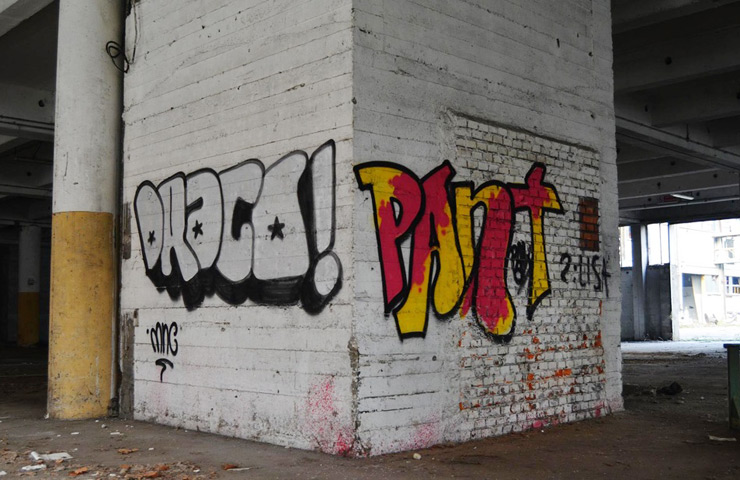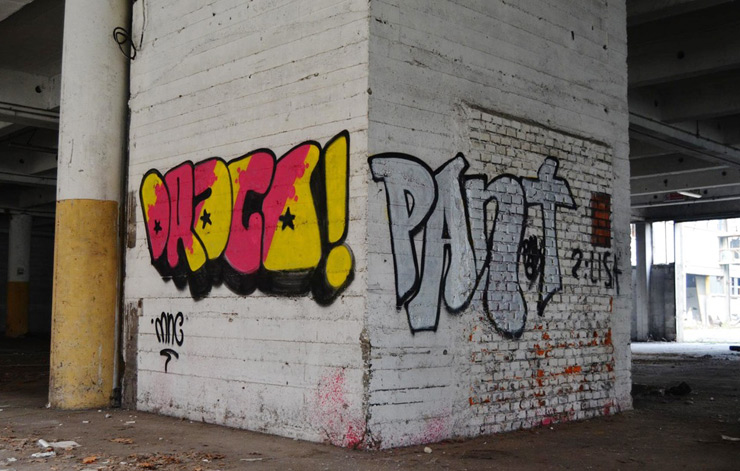In his latest theoretical and conceptual performance project with the graffiti tags of others, Biancoshock (formerly Fra. Biancoshock) switches the color palettes of two pieces that are located near one another to “demonstrate that interchanging the colors doesn’t change the result.
Over the last two years the artist has done 3 of these “actions”, as he refers to them. “I’ve interchanged the colors of the graffiti without modifying the outline of the pieces,” he says, explaining that he took special pains to research and find “the exact color tone in order to substitute the color of each piece.”
Joke and Kream original work. Italy. (photo © Biancoshock)
Biancoshock “Commutative” intervention on the original pieces. (photo © Biancoshock)
In Biancoshock’s view the resulting pieces are the equivalent of a provocation to the original writers. “The act is minimal but very strong because in the graffiti world this could be perceived as an act of blasphemy; almost like writing “TOY” on someone else’s graffiti. Possibly it’s even worse because is like a sacrilege to alter a graffiti done by another.”
But he says that evoking the ire of various writers by making these color switches without permission is not the aim of the project. “I’ve done this to demonstrate that even if the order of the colors is changed, the result doesn’t change. Biancoshock sites his own interpretation of the commutative property in arithmetic.
Biancoshock at work on Joke and Kream works. (photo © Biancoshock)
And truthfully, we could agree with him until he made that statement, then the argument falls apart for us. “Graffiti are graffiti- they have a presence in the urban context, they have a story, a message, are signs of a passage – all independently of their more technical aspects, such as coloring or style,” he says,
“I believe that if I showed to the author of these graffiti pieces after many years these ‘modified’ pieces, they probably would not remember the color, but they certainly remember to have done that piece, because graffiti are for writers a little piece of their life, of personal history.”
Spid and Fish original work. Italy. (photo © Biancoshock)
Biancoshock “Commutative” intervention on the original pieces. (photo © Biancoshock)
It is an interesting project and it would be interesting to hear what the original author of these changed works would think.
But with all due respect, to say that the results are the same is to be color blind and insensitive to the characteristics which cultures and traditions have historically assigned to colors. Red may infer urgent danger to one person, but good luck to another. White calls to mind a funeral in some cultures, a wedding in others. For years baby showers featured a predominance of pink items for a new girl and blue clothes and toys for boys.
Also, need we mention that many artists have favorite colors or palettes, and it is doubtful that colors here are completely arbitrary and lacking in meaning to their original creators. He mentions piece are a little piece of the writers life and personal history, which is precisely the reason why colors will be important to them ultimately.
Biancoshock at work on Spid and Fish works. (photo © Biancoshock)
In math a binary operation is commutative if changing the order of the operands does not change the result, but in this case the result has changed as well. We are not sure we can agree with the artist that the outcome is the same using different colors.
But congratulations to Biancoshock for this visually and intellectually stimulating project and our sincere thanks for sharing these exclusive images with BSA readers. Biancoshock also asked if we would post his statement as follows: “I apologize to Fish, Spid, Kream, Joke, Draco and Pant for this action, I hope they understand my purpose.”
Draco and Pant original work. Italy. (photo © Biancoshock)
Biancoshock “Commutative” intervention on the original pieces. (photo © Biancoshock)
Biancoshock at work on Draco and Pant works. (photo © Biancoshock)
Other Articles You May Like from BSA:
Welcome to BSA's Images of the Week, where we take you on a tour to see what has been popping up on the streets of our fair city. "Banksy unveils 7th piece of street art over last week in draw...
A colorful harvest of local folk on walls here as we bring you images Nether has been painting this summer in his native Baltimore by himself and with friends. A mix of community projects and independ...
“I drew inspiration from Joseph Beuys’ visit to Ireland where he spoke in the gallery about the soul and its transition between different levels of existence.” Street artist Asbestos is talking about...
Indeed, the Grenoble Street Art Festival in France doesn’t care about you unless you parlez français – at least that's the impression you'll get from their website and social media. Nevertheless, they...
The “Beautiful Times” tour by Amanda Marie and X-0 has brought them back to Denver Colorado where it began. We shared with you images and a semi-travelogue for their earlier installations along this s...
 BROOKLYN STREET ART LOVES YOU MORE EVERY DAY
BROOKLYN STREET ART LOVES YOU MORE EVERY DAY